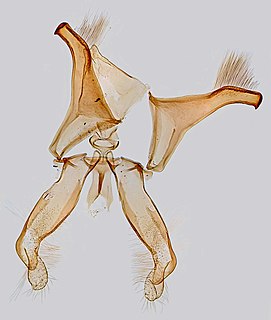
The shark is a moth of the family Noctuidae. The species was first described by Carl Linnaeus in his landmark 1758 10th edition of Systema Naturae.

Amblyptilia acanthadactyla, also known as the beautiful plume, is a moth of the family Pterophoroidea found in across the Palearctic including Europe. The species was first described by the German entomologist, Jacob Hübner in 1813.

Hellinsia osteodactyla is a moth of the family Pterophoridae. It is found in most of Europe, as well as North Africa and from Asia Minor to Japan. Also known as the small golden-rod plume it was first described by Philipp Christoph Zeller in 1841.

Hellinsia lienigianus is a moth of the family Pterophoridae which inhabits coastal areas, dry pastures and waste ground and is found in Africa, Asia, Australia and Europe. Also known as the mugwort plume it was first described by Philipp Christoph Zeller in 1852.

Agdistis meridionalis, the sea-side plume, is a moth of the family Pterophoridae, first described by the German entomologist Philipp Christoph Zeller in 1847. It is found in Europe.

Platyptilia farfarellus is a moth of the family Pterophoridae. The species was described by Philipp Christoph Zeller in 1867. It is found from central and southern Europe to Asia Minor, Micronesia and Japan. It is also known from Africa, where it has been recorded from Equatorial Guinea, Kenya, Madagascar, Mauritius, Nigeria, South Africa, São Tomé & Principe, Tanzania, Uganda, the Seychelles and Malawi.

Amblyptilia punctidactyla, also known as the brindle plume, is a moth of the family Pterophoridae found in across the Palearctic. The species was first described by the English entomologist, Adrian Hardy Haworth in 1811.

Buckleria paludum, the European sundew moth, is a moth of the family Pterophoridae first described by Philipp Christoph Zeller in 1839. It is found in Asia and Europe.

Crombrugghia is a genus of moths in the family Pterophoridae. It was erected by James William Tutt in 1906.
Agdistis tamaricis is a moth of the family Pterophoridae found in Africa, Asia and Europe. It was first described by the German entomologist, Philipp Christoph Zeller in 1847.

Oxyptilus pilosellae is a moth of the family Pterophoridae first described by Philipp Christoph Zeller in 1841. It is found in most of Europe, east to Russia and Asia Minor. It was released as a biological control agent for Hieracium in New Zealand in 1998.

Oxyptilus parvidactyla, also known as the small plume, is a moth of the family Pterophoridae found in Africa, Asia and Europe. It was first described by Adrian Hardy Haworth in 1811.

Crombrugghia laetus, also known as the scarce light plume is a moth of the family Pterophoridae, found in southern Europe, North Africa, the Canary Islands, Asia Minor and Iraq. It was first described by Philipp Christoph Zeller in 1847.
Stenoptilia annadactyla, also known as the small scabious plume, is a moth of the family Pterophoridae. It was first described by Reinhard Sutter in 1988 and is found in Europe.

Merrifieldia leucodactyla, also known as the thyme plume, is a moth of the family Pterophoridae, and is known from most of Europe, as well as North Africa and Asia Minor. It was first described by the Austrian lepidopterists, Michael Denis and Ignaz Schiffermüller in 1775).
Merrifieldia tridactyla, also known as the western thyme plume, is a moth of the family Pterophoridae, first described by Carl Linnaeus in his 10th edition of Systema Naturae in 1758. It is known from most of Europe, as well as North Africa and Asia Minor.

Merrifieldia baliodactylus, also known as the dingy white plume, is a moth of the family Pterophoridae found in most of Europe. It was first described by the German entomologist, Philipp Christoph Zeller in 1841.

Hellinsia carphodactyla is a moth of the family Pterophoridae, first described by Jacob Hübner in 1813. It is known from most of Europe, Asia Minor and North Africa.

Pselnophorus heterodactyla, also known as the short-winged plume, is a moth of the family Pterophoridae found in most of Europe. It was first described by Danish naturalist, Otto Friedrich Müller in 1764.

Crombrugghia tristis is a moth of the family Pterophoridae. It is found in most of Europe, except the Benelux, Great Britain, Ireland and Scandinavia. It is also known from southern Siberia, Asia Minor and central Asia. The habitat consists of sandy areas overgrown with Hieracium.

















